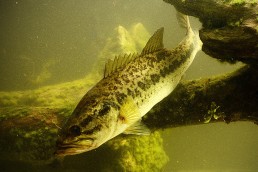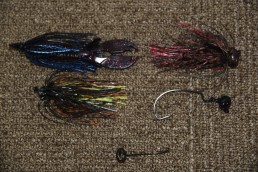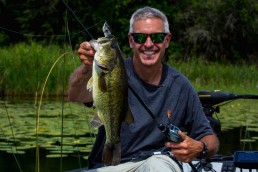How Important is Lateral Line Sense in Largemouths?
SHARE THIS POST
Sight and lateral line is what most often accounts for bass striking lures. Hearing is important too, but the primary level and function of these senses varies upon the water body, forage base, structure or weather. What a largemouth senses and the role it plays has dominated fishing media, and lure manufacturers are aware of our tendency to grab lures with vibration, lifelike appeal, flash and multiple noise chambers. The newer lures’ purpose remains the same, which is to create an overall impression bass haven’t seen or know well and that make the fish attack.
As we hit the water, having several presentations is a plus. A common question is: How does the lateral line affect bass and their tendency to strike or avoid any given lure?
The lateral line becomes the focus when we talk about what draws bass to inhale a lure. The belief that the lateral line signals the majority of bass bites appears most prevalent in recent thought. We have just gotten over a huge rattling crankbait resurgence. Bluegill-patterned lipless crankbaits were huge not long ago along with the still venerable Spro Araku Shad. Obviously, we are thinking about vibration, flash and noise with these lures and the effectiveness of rattling baits during fall is undisputed.
Old favorites always seem to make comebacks in the pursuit of bass. The 2017 lineup of Savage Gear 3D Suicide Duck and Rad (rat) forces me to reminisce when a good friend of mine was an old bass lure- collecting fanatic. The various hard baits tried to replicate real forage, and lure concepts do not stay out of production for long in the bass-fishing arena.
Skirted jigs and a myriad of trailer options offer numerous combinations, and enthusiasts of jig-and-trailer combos maintain that the bottom-bouncing appeal is natural. But it’s the jig-vibration combination mimicking what bass see on a daily basis that is important when selecting a lure.
In the past, the lateral line usually got overlooked when including these variables. I’ve used the most lifelike replica crankbaits and have not gotten strikes in relatively clear water, whereas a stick worm, jig or dull brown rattle bait worked. There are just too many factors, and we’re only gathering a snapshot of the possibilities when we fish for a few hours. But a culmination of days spent on the water increases our knowledge and awareness, especially if the conditions stay warm and favorable for higher levels of bass activity.
Are you enjoying this post?
You can be among the first to get the latest info on where to go, what to use and how to use it!
If you are fishing outside of midsummer, changes are unavoidable. Factor in water clarity and types and density of cover and we have quite a bit of sorting to do. A presentation on one body of water may not work on another, but preparing for challenging conditions can be a sound strategy.
A bass merely seeing a lure is not enough of a factor to force them to strike. The Glen Lau Bigmouth movie-video was the first production to actually send scuba divers in the water to see how bass strike lures. It was filmed 43 years ago, but we can note that certain aspects of a lure will get the attention of a bass, only to have them bypass that lure. Other lures get a neutral-active response where a bass inhales a crankbait with just enough resistance to exhale it. This proves that an effective combination of peeking a bass’ senses is critical for them striking a lure and committing to an attack.
The bass world is filled with all varieties of natural prey, and this species can figure that something is out of place pretty quickly in terms of presentation. Anglers need to possess more than just one set of skills on the water. Those most adept are thorough and the most versatile multitaskers I’ve ever witnessed. Compared to fishing for other species, these traits can make largemouth angling unique and also intimidating.
I’d rather use a simple method for calculating if I’m getting enough strikes. I’ll first ask myself if I’m getting the size of bass I want or the numbers I know this location holds. I just want to maximize a location. An example would be fishing a crankbait in early fall with clear water. You are fairly sure to get aggressive bites on a crankbait with bass committing to this with strikes that are impossible to miss. You may cast a lipped, natural shad-patterned crankbait and catch nothing. But the second choice as a rattling crank in a slightly brighter color with some fleck added to it with rattles can net quality fish from the same location you casted that shad crankbait minutes earlier. Your success and experience has been gained knowing that the initial rejection of the first crankbait only required you to switch up lures and not to fish a different family of baits, downsize a presentation or move your location. This is the power of lateral-line bass knowledge—a thoroughly vital tool on any body of water regardless of conditions.
It’s astounding to think one gamefish would hit lures that visually have nothing in common. Even topwaters, crankbaits and spinnerbaits all look different, not to mention how varied the entire family of bass soft plastics is. Staring down in that tackle or utility box and trying to work magic inevitably offers more choices than ever. We can certainly plug these options into the correct sequence of conditions. But it’s that knowledge of lateral line and applying it on a favorite spot that can make the difference between landing a few and seeing the best outing of the year. Regardless if you’re a weekend angler, just starting tournaments or are a seasoned pro, the lateral line sense connection can be used with all of your presentations. Today’s bass world demands we have a little edge when hitting the water, and lateral line knowledge will allow you to attain that.
MWO
SHARE THIS POST
Did you enjoy this post?
You can be among the first to get the latest info on where to go, what to use and how to use it!
Frank Racz
With almost two decades of fishing retail knowledge, Frank Racz’s dedication to the “stitching technique” has led to a modern Midwestern largemouth bass variant and bluegill pursuits. He is avid about the techniques’ multispecies potential and other long spinning rod inquiries featured on his YouTube channel.



